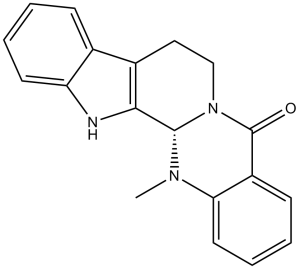This product is for research use only, not for human use. We do not sell to patients.

| Size | Price | Stock |
|---|---|---|
| 2g | $450 | Check With Us |
| 5g | $850 | Check With Us |
| 10g | $1275 | Check With Us |
Cat #: V2020 CAS #: 518-17-2 Purity ≥ 98%
Description: Evodiamine (d-Evodiamine; Q-100579; SC-16015; Evo; Isoevodiamine) is a naturally occuring quinazolinocarboline alkaloid extracted from the fruit of Evodiae Fructus, exhibiting moderate antiproliferative activities against various human tumor cells.
Publications Citing InvivoChem Products
Product Promise

- Physicochemical and Storage Information
- Protocol
- Related Biological Data
- Stock Solution Preparation
- Quality Control Documentation
| Molecular Weight (MW) | 303.36 |
|---|---|
| Molecular Formula | C19H17N3O |
| CAS No. | 518-17-2 |
| Storage | -20℃ for 3 years in powder formr |
| -80℃ for 2 years in solvent | |
| Solubility In Vitro | DMSO: <1 mg/mLr |
| Water: <1 mg/mLr | |
| Ethanol: <1 mg/mL | |
| SMILES Code | O=C1N2[C@](C(NC3=C4C=CC=C3)=C4CC2)([H])N(C)C5=C1C=CC=C5 |
| Synonyms | Isoevodiamine; (+)-Evodiamine; d-Evodiamine; Q-100579; SC-16015; Q100579; SC16015; Q 100579; SC 16015 |
| Protocol | In Vitro | It is found that Indole-3-carbinol (I3C) inhibits the proliferation of THP-1 cells in a dose- and time dependent manner with minimal toxicity over normal monocytes. The AhR target genes (CYP1A1, IL1β) are overexpressed upon Indole-3-carbinol treatment (p<0.05 to p<0.001). The antiproliferative effects of Indole-3-carbinol are in association with programing cell death. Indole-3-carbinol downregulates BCL2 and upregulates FasR in THP-1 cells (p<0.05 to p<0.001). G1 cell cycle arrest is also observed using flow cytometry. G1-acting cell cycle genes (P21, P27 and P53) are overexpressed (p<0.05 to p<0.001), while CDK2 is downregulated upon Indole-3-carbinol treatment (p<0.01 to p<0.001). |
|---|
| Solvent volume to be added | Mass (the weight of a compound) | |||
|---|---|---|---|---|
| Mother liquor concentration | 1mg | 5mg | 10mg | 20mg |
| 1mM | 3.2964 mL | 16.4821 mL | 32.9641 mL | 65.9283 mL |
| 5mM | 0.6593 mL | 3.2964 mL | 6.5928 mL | 13.1857 mL |
| 10mM | 0.3296 mL | 1.6482 mL | 3.2964 mL | 6.5928 mL |
| 20mM | 0.1648 mL | 0.8241 mL | 1.6482 mL | 3.2964 mL |
This equation is commonly abbreviated as: C1 V1 = C2 V2
- (1) Please be sure that the solution is clear before the addition of next solvent. Dissolution methods like vortex, ultrasound or warming and heat may be used to aid dissolving.
- (2) Be sure to add the solvent(s) in order.




































